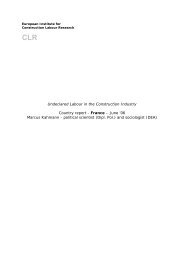Japan – what can we learn? - Construction Labour Research
Japan – what can we learn? - Construction Labour Research
Japan – what can we learn? - Construction Labour Research
Create successful ePaper yourself
Turn your PDF publications into a flip-book with our unique Google optimized e-Paper software.
usual material. The quality seems to be higher, but I am not certainabout this.Differences exist bet<strong>we</strong>en rural and urban sites, large and small sites.Thus, there is not the one typical <strong>Japan</strong>ese building site. But withregard to house building, which is very much the building of smallwooden houses with two (or <strong>–</strong> rarely <strong>–</strong> three) stories, it is typical towork with machines for the groundwork, but (almost) no machines forthe assembly, fixing and finishing. Here you have typically three‘professions’ on site: carpenters, painters, and sheet metal workers.They are skilled workers, although there is no general system ofvocational training.The firms serving the housing market are called ‘house makers’. Theystart their work on site with the groundwork. They offer a financingbargain to buyers, but there is almost no production chain. The ‘housemakers’ work with their own (but little) machinery and own workers.There are not only small firms active but large ones as <strong>we</strong>ll.With regard to large building sites, there is again a certain pattern tobe found: All the machinery <strong>we</strong> know from ‘Western’ sites is usedhere, too, e.g. to<strong>we</strong>r-cranes, mobile cranes, bulldozers … on thesesites you hardly find any skilled worker; they are unskilled or semiskilled(steeple-jacks). The <strong>Japan</strong>ese interview partners called this an‘Ameri<strong>can</strong>ised’ system.On such sites you regularly find a highly fragmented production chainwith a general contractor on top, which <strong>can</strong> be the building section ofone of the huge <strong>Japan</strong>ese business groups (though you find thesesections more as the client). This general contractor does not have itsown workers on site but is only busy with management and financing.Normally the client pays a fixed amount of money and the generalcontractor’s duty is to run the project with the money available. Thus,it employs the first level of subcontractors, which then employ thenext level and so on. At the end of this commonly existing long chain,you find to a large extent those who are self-employed (officially thereare half a million self-employed workers on <strong>Japan</strong>ese sites).CLR News No 2/200612









